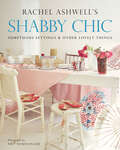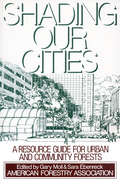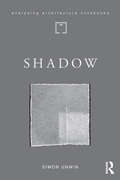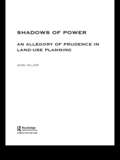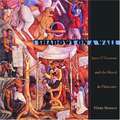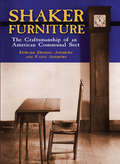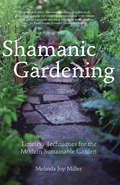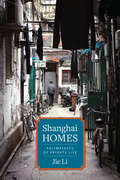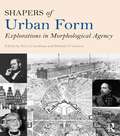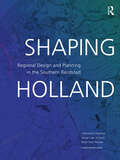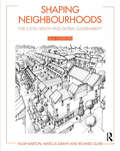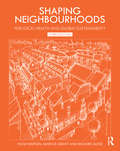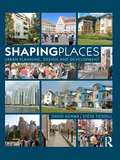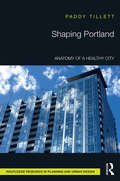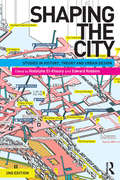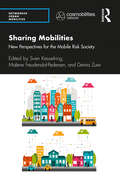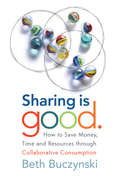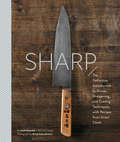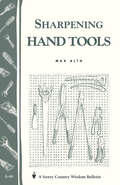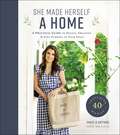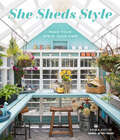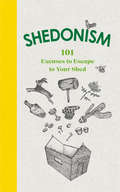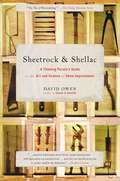- Table View
- List View
Shabby Chic: Sumptuous Settings And Other Lovely Things
by Rachel AshwellCreating beautiful, sumptuous settings for any occasion!Top designer Rachel Ashwell, founder of the Shabby Chic line, is known for her trademark style of transforming drab interiors into warm, inviting spaces. Simply by incorporating a few design elements and a splash of color, Rachel is able to make any environment, whether it's a home or a special event, beautiful and fun. In Shabby Chic: Sumptuous Settings and Other Lovely Things, Rachel proves that her style isn't simply about creating an attractive home but also about creating joyful and pleasant settings for those we love. In this beautiful volume, Rachel applies her distinct eye for style to six very different locations and celebrations, and offers helpful tips on how to host whimsical and unforgettable events.Whether it is casual or formal, big or small, this beautiful book proves that entertaining need not be expensive. From flea markets to local antiques malls, Rachel reveals that the trick to making any event or space something elegant—without breaking the bank—is simply a matter of inspiration, imagination, and the discovery of a fabulous buy.Inside, you'll find practical ideas for any occasion, baby showers to weddings, birthday parties to bar mitzvahs. When it comes to setting a scene, Rachel is an expert and with her easy how-to advice, you can be too.Rachel Ashwell is the creator of the Shabby Chic style. In 1989, she founded the Shabby Chic home furnishing stores and then later, the Rachel Ashwell Shabby Chic Couture stores. She is the author of Shabby Chic, Rachel Ashwell's Shabby Chic Treasure Hunting and Decorating Guide, The Shabby Chic Home, and Shabby Chic: The Gift of Giving.
Shading Our Cities: A Resource Guide For Urban And Community Forests
by Sara Ebenreck Gary Moll Dale Robertson American Forestry AssociationShading Our Cities is a handbook to help neighborhood groups, local officials, and city planners develop urban forestry projects, not only to beautify their cities, but also to reduce energy demand, improve air quality, protect water supplies, and contribute to healthier living conditions.
Shadow: the architectural power of withholding light (Analysing Architecture Notebooks)
by Simon UnwinEach of these Analysing Architecture Notebooks is devoted to a particular theme in understanding the rich and varied workings of architecture. They can be thought of as addenda to the foundation volume Analysing Architecture, which first appeared in 1997 and has subsequently been enlarged in three further editions. Examining these extra themes as a series of Notebooks, rather than as additional chapters in future editions, allows greater space for more detailed exploration of a wider variety of examples, whilst avoiding the risk of the original book becoming unwieldy. Shadows may be insubstantial but they are, nevertheless, an important element in architecture. In prehistoric times we sought shade as a refuge from the hot sun and chilling rain. Through history architects have used shadows to draw, to mould form, to paint pictures, to orchestrate atmosphere, to indicate the passing of time … as well as to identify place. Sometimes shadow can be the substance of architecture.
Shadows of Power: An Allegory of Prudence in Land-Use Planning (RTPI Library Series)
by Jean HillierShadows of Power examines public policy and in particular, the communicative processes of policy and decision-making. It explore the important who, how and why issues of policy decisions. Who really takes the decisions? How are they arrived at and why were such processes used? What relations of power may be revealed between the various participants?Using stories from planning practices, this book shows that local planning decisions, particularly those which involve consideration of issues of 'public space' cannot be understood separately from the socially constructed, subjective territorial identities, meanings and values of the local people and the planners concerned. Nor can it be fully represented as a linear planning process concentrating on traditional planning policy-making and decision-making ideas of survey analysis-plan or officer recommendation-council decision-implementation. Such notions assume that policy-and decision-making proceed in a relatively technocratic and value neutral, unidirectional, step-wise process towards a finite end point. In this book Jean Hiller explores ways in which different values and mind-sets may affect planning outcomes and relate to systemic power structures. By unpacking these and bring them together as influences on participants' communication, she reveals influences at work in decision-making processes that were previously invisible.If planning theory is to be of real use to practitioners, it needs to address practice as it is actually encountered in the worlds of planning officers and elected representatives. Hillier shed light on the shadows so that practitioners may be better able to understand the circumstances in which they find themselves and act more effectively in what is in reality a messy, highly politicised decision-making process.
Shadows on a Wall: Juan O'Gorman and the Mural in Pátzcuaro
by Hilary MastersNovelist and essayist Hilary Masters recreates a moment in 1940s Pittsburgh when circumstances, ideology, and a passion for the arts collided to produce a masterpiece in another part of the world.
Shaker Furniture
by Edward D. Andrews48 sharp photos show side chairs, long benches, rocking chairs, chests, cupboards, much more. Exact measurements given for each piece to aid in identification, reconstruction, restoration. Also--highly readable commentary on sect's cultural background.
Shamanic Gardening
by Melinda Joy MillerA shaman is one who walks in two worlds, one seen easily by everyone, another seen with the senses of the heart, deep recesses of the mind, and within the collective spiritual consciousness. Shamanic Gardening integrates sustainable ancient and traditional gardening methods with shamanic principles and modern permaculture. The practices, history, myths, recipes, and philosophies inside this book will enhance your relationship with nature, sustain the earth, delight your senses, and nourish your soul. Shamanic Gardening includes a cultural history of sustainable gardening, including gardening techniques used by Cleopatra, the Japanese, The Pueblo Indians, George Washington and Thomas Jefferson, and many others. This book teaches both simple and advanced techniques to garden with more awareness and effectiveness, using your inner senses. Learn to design an elegant, edible, sustainable landscape, plant for nutrition and beauty, grow healing herbs and aphrodisiacs, work with earth energies and color, extract flower essences, and much more. Melinda Joy Miller is a feng shui master, cultural anthropologist, medicine woman, and Keeper of the Medicine Wheel of Peace teachings of the Senecas. She has been practicing and teaching permaculture techniques and shamanic healing for over thirty years.
Shanghai Homes: Palimpsests of Private Life
by Jie LiExploring three dimensions of private life territories, artifacts, and gossip Li re-creates the sounds, smells, look, and feel of home over a tumultuous century
Shanghai Homes: Palimpsests of Private Life (Global Chinese Culture)
by Jie LiIn the dazzling global metropolis of Shanghai, what has it meant to call this city home? In this account—part microhistory, part memoir—Jie Li salvages intimate recollections by successive generations of inhabitants of two vibrant, culturally mixed Shanghai alleyways from the Republican, Maoist, and post-Mao eras. Exploring three dimensions of private life—territories, artifacts, and gossip—Li re-creates the sounds, smells, look, and feel of home over a tumultuous century. First built by British and Japanese companies in 1915 and 1927, the two homes at the center of this narrative were located in an industrial part of the former "International Settlement." Before their recent demolition, they were nestled in Shanghai's labyrinthine alleyways, which housed more than half of the city's population from the Sino-Japanese War to the Cultural Revolution. Through interviews with her own family members as well as their neighbors, classmates, and co-workers, Li weaves a complex social tapestry reflecting the lived experiences of ordinary people struggling to absorb and adapt to major historical change. These voices include workers, intellectuals, Communists, Nationalists, foreigners, compradors, wives, concubines, and children who all fought for a foothold and haven in this city, witnessing spectacles so full of farce and pathos they could only be whispered as secret histories.
Shapers of Urban Form: Explorations in Morphological Agency
by Peter J. Larkham Michael P. ConzenPeople have designed cities long before there were urban designers. In Shapers of Urban Form, Peter Larkham and Michael Conzen have commissioned new scholarship on the forces, people, and institutions that have shaped cities from the Middle Ages to the present day. Larkham and Conzen collect new essays in "urban morphology," the people-centered predecessor to contemporary theories of top-down urban design. Shapers of Urban Form focuses on the social processes that create patterns of urban forms in four discrete periods: Pre-modern, early modern, industrial-era and postmodern development. Featuring studies of English, American, Western and Eastern European, and New Zealand urban history and urban form, this collection is invaluable to scholars of urban design and town planning, as well as urban and economic historians.
Shaping Holland: Regional Design and Planning in the Southern Randstad
by Jeroen van Schaick Francisco Colombo Peter WitsenAll around the world, regions are facing major challenges: climate change, the transition to renewable energy, reinventing the food system, ongoing urbanisation and finding room to sustain biodiversity. These will radically transform our living and working environments. Regional design uses the power of visualisation to unite regional players around appealing spatial development visions for meeting those challenges. It offers a route to new forms of regional governance and planning that match the urgencies of our time. This book exposes the benefits and the pitfalls of regional plans and designs. Shaping Holland gives a unique insight into the emergence of contemporary regional planning and design practice in the Netherlands. This densely populated country in the delta of the Rhine and Meuse rivers is internationally renowned for its urban planning and design tradition. Drawing on first-hand accounts and a rich collection of illustrations, maps and diagrams, the book gives pointers for practitioners, academics and students of spatial planning, urban design and landscape architecture. Regional design is on the rise in all continents. It provides an answer to a world in which economic activities, activity patterns, urban growth and ecological systems are no respecters of administrative boundaries. Amid the growing number of academic analyses of regional design, this book is unique because it focuses on planning practice and first-hand knowledge. As such it is of interest to a broad international readership.
Shaping Neighbourhoods: For Local Health and Global Sustainability
by Hugh Barton Marcus Grant Richard GuiseThis substantially revised and important second edition comes at a pivotal time, with both a strong agenda of localism in planning and with public health professionals now realising the vital importance of shaping urban environments in order to reduce the burden of disease and support better health outcomes. This guide ensures you: understand the underlying principles for planning healthy and sustainable neighbourhoods and towns plan the collaborative and inclusive processes needed for multi-sectoral cooperation develop know-how and skills in matching local need with urban form discover new ways to integrate development with natural systems design places with character and recognise good urban form guide communities, and advise developers, in the creation of successful and sustainable places for living. Containing many new case studies and a wealth of new research, this new edition has benefited from previous user feedback. Shaping Neighbourhoods is the indispensable guide for bridging the gulf between theory and practice, between planning authorities, investors and communities, and between different professional perspectives. Whether you are a student faced with a local planning project; a planner, urban designer or developer involved in new development; a health authority concerned with promoting physical activity; or a community group wanting to improve your neighbourhood; this book is for you.
Shaping Neighbourhoods: For Local Health and Global Sustainability
by Hugh Barton Marcus Grant Richard GuiseShaping Neighbourhoods is unique in combining all aspects of the spatial planning of neighbourhoods and towns whilst emphasising positive outcomes for people’s health and global sustainability. This new edition retains the combination of radicalism, evidence-based advice and pragmatism that made earlier editions so popular. This updated edition strengthens guidance in relation to climate change and biodiversity, tackling crises of population health that are pushing up health-care budgets, but have elements of their origins in poor place spatial planning – such as isolation, lack of everyday physical activity, and respiratory problems. It is underpinned by new research into how people use their localities, and the best way to achieve inclusive, healthy, low-carbon settlements. The guide can assist with: • Understanding the principles for planning healthy and sustainable neighbourhoods and towns • Planning collaborative and inclusive processes for multi-sectoral working • Developing know-how and skills in matching local need with urban form • Discovering new ways to integrate development with natural systems • Designing places with character and recognising good urban form Whether you are a student faced with a local planning project; a public health professional, planner, urban designer or developer involved in new development or regeneration; a council concerned with promoting healthy and sustainable environments; or a community group wanting to improve your neighbourhood – you will find help here.
Shaping Places: Urban Planning, Design and Development
by David Adams Steve TiesdellShaping Places explains how towns and cities can turn real estate development to their advantage to create the kind of places where people want to live, work, relax and invest. It contends that the production of quality places which enhance economic prosperity, social cohesion and environmental sustainability require a transformation of market outcomes. The core of the book explores why this is essential, and how it can be delivered, by linking a clear vision for the future with the necessary means to achieve it. Crucially, the book argues that public authorities should seek to shape, regulate and stimulate real estate development so that developers, landowners and funders see real benefit in creating better places. Key to this is seeing planners as market actors, whose potential to shape the built environment depends on their capacity to understand and transform the embedded attitudes and practices of other market actors. This requires planners to be skilled in understanding the political economy of real estate development and successful in changing its outcomes through smart intervention. Drawing on a strong theoretical framework, the book reveals how the future of places will come to be shaped through constant interaction between State and market power. Filled with international examples, essential case studies, color diagrams and photographs, this is essential reading for undergraduate and graduate students taking planning, property, real estate or urban design courses as well as for social science students more widely who wish to know how the shaping of place really occurs.
Shaping Portland: Anatomy of a Healthy City
by Paddy TillettPortland is a young city founded on a river bank in a virgin forest less than 200 years ago. Shaping Portland: Anatomy of a Healthy City is about the values engendered by the place, and how those values have influenced the growing city. It examines how and why the public realm supports or obstructs the health-forward lifestyles of those who choose to live there. This book explores the values and dynamics that shaped a healthy city to enable those things. It is a case study of a recognized success – looking more closely at a recent urban infill: the Pearl District. The future roles of the planners and other design professionals in continuing to build healthy and responsive environments are suggested. The cities of the future will be those that we already inhabit, but infilled and adapted to tomorrow’s needs and values. Understanding the dynamics involved is essential for those in whose hands we entrust the design of cities and urban places.
Shaping the American Interior: Structures, Contexts and Practices
by Penny Sparke Paula LupkinBringing together 12 original essays, Shaping the American Interior maps out, for the first time, the development and definition of the field of interiors in the United States in the period from 1870 until 1960. Its interdisciplinary approach encompasses a broad range of people, contexts, and practices, revealing the design of the interior as a collaborative modern enterprise comprising art, design, manufacture, commerce, and identity construction. Rooted in the expansion of mass production and consumption in the last years of the nineteenth century, new and diverse structures came to define the field and provide formal and informal contexts for design work. Intertwined with, but distinct from, architecture and merchandising, interiors encompassed a diffuse range of individuals, institutions, and organizations engaged in the definition of identity, the development of expertise, and the promotion of consumption. This volume investigates the fluid pre-history of the American profession of interior design, charting attempts to commoditize taste, shape modern conceptions of gender and professionalism, define expertise and authority through principles and standards, marry art with industry and commerce, and shape mass culture in the United States.
Shaping the City: Studies in History, Theory and Urban Design
by Rodolphe El-Khoury Edward RobbinsTaking on the key issues in urban design, Shaping the City examines the critical ideas that have driven these themes and debates through a study of particular cities at important periods in their development. As well as retaining crucial discussions about cities such as Los Angeles, Atlanta, Chicago, Detroit, Philadelphia, and Brasilia at particular moments in their history that exemplified the problems and themes at hand like the mega-city, the post-colonial city and New Urbanism, in this new edition the editors have introduced new case studies critical to any study of contemporary urbanism – China, Dubai, Tijuana and the wider issues of informal cities in the Global South. The book serves as both a textbook for classes in urban design, planning and theory and is also attractive to the increasing interest in urbanism by scholars in other fields. Shaping the City provides an essential overview of the range and variety of urbanisms and urban issues that are critical to an understanding of contemporary urbanism.
Sharing Mobilities: New Perspectives for the Mobile Risk Society (Networked Urban Mobilities Series)
by Dennis Zuev Sven Kesselring Malene Freudendal-PedersenSharing Mobilities focuses on the emergence of future sustainable and collaborative mobility cultures. At the intersection of physical and virtual capacity and access to people, goods, ideas, and services, this book poses fundamental challenges and opportunities for governance, economy, planning, and identity. The future of new collaborative forms of consumption and sharing would play a key role in the organization of everyday life and business. Sharing mobilities is more than simply sharing transport, and its diverse impacts on society and the environment demand thorough theory-led sociological research. With an extensive global range, the contributors present radical manifestations of sharing capacities throughout diverse countries, including Germany, Denmark, Japan, and Vietnam. The phenomenon of mobility is highly actual and social as well as politically relevant and urging. This collection focuses on open questions from the perspective of the mobilities turn while presenting state-of-the-art theory-based articles with applied perspectives. An ideal read for scholars based in social science and the interdisciplinary research on mobility, transports, and sharing economy. Sociologists, geographers, economists, urban governance researchers, and research students would also find this book of interest.
Sharing is Good
by Beth BuczynskiCollaborative consumption is a new way of living in which access is valued above ownership, experience is prized over material possessions, and "mine" becomes "ours," allowing everyone's needs to be met with minimum waste. Bursting at the seams with hundreds of helpful tips and valuable resources, Sharing is Good is a practical guide to this new and exciting "sharing economy."
Sharp: The Definitive Guide to Knives, Knife Care, and Cutting Techniques, with Recipes from Great Chefs
by Josh Donald Molly DeCoudreauxSharp is a knife skills class in book form and an introduction to the best knives you can buy from all over the world. From a premier knife purveyor and go-to knives expert, this comprehensive guide details the elements of buying and caring for good knives, including sharpening and knife skills. Step-by-step instructions and photography cover a range of techniques with 15 recipes from great chefs—including Stuart Brioza of State Bird Provisions and Melissa Perello of Frances—which feature all the cuts that mark an accomplished cook. Sharply packaged with a textured cover, a foil spine, and more than 150 striking photographs of knifemakers, coveted knives, and beautiful food, this is the cookbook, handbook, and visual journey for anyone wanting to hone their skills in the kitchen.
Sharpening Hand Tools: Storey's Country Wisdom Bulletin A-66
by Max AlthSince 1973, Storey's Country Wisdom Bulletins have offered practical, hands-on instructions designed to help readers master dozens of country living skills quickly and easily. There are now more than 170 titles in this series, and their remarkable popularity reflects the common desire of country and city dwellers alike to cultivate personal independence in everyday life.
She Made Herself a Home: A Practical Guide to Design, Organize, and Give Purpose to Your Space
by Rachel Van KluyvePopular blogger Rachel Van Kluyve of Crate & Cottage, along with a community of other successful home décor bloggers, offers up practical design tips in this beautiful lifestyle book for women who want to create lovely, budget-friendly, intentional spaces for themselves and their families.Create a home that's inviting, beautiful, and uniquely you—all while staying on a budget. Whether you're decorating your first home, planning for renovations, or simply looking for an affordable refresh, She Made Herself a Home is the ideal home décor planner to help you tap into your creative side and instill the confidence you need to get started. Women of all ages who care about their family's personal spaces will find that this guide makes designing a home with function and beauty an exciting, unintimidating prospect.With ideas adaptable to any décor story, Rachel walks her readers through each space in a home, listing a room's must-haves and providing easy steps to determine a layout that works best for each individual's home. Rachel also provides the best tips for choosing the right item for your space, finding great deals, and keeping it all organized. Alongside photography of Rachel's gorgeous home, She Made Herself a Home features favorite photos and ideas from many other popular home décor bloggers, whose unique styles offer extra inspiration.You don't have to break the bank to bring new life and purpose into your home. With design expertise from Rachel and others, you can confidently take action to create the beautiful, peaceful home you've dreamed of.
She Sheds Style: Make Your Space Your Own
by Erika Kotite“A charming primer . . . Part practical decorating handbook and part empowerment guide for women, this book on mini-scaled spaces is full-scale fun.” —Publishers WeeklyIt’s no secret that the she shed revolution is underway and gaining steam. What is a she shed? It’s simply any outbuilding that has been renovated, outfitted, redesigned, or otherwise reassigned into service as a refuge from the intense pace of modern life. Consider it a woman’s response to the “man cave” craze.Whether you already have that sought-after shed or are still in the dreaming phase, home and lifestyle expert Erika Kotite—author of the bestselling She Sheds: A Room of Your Own—will help you on your journey.Browse gorgeous photos of a variety of sheds and shed interiors, which range from modern and eclectic to rustic and shabby chic.Learn what architectural details play into a shed’s look and consider how these elements work with your preferred decor.Explore dozens of DIY projects: breathe new life into old furniture, install a track door, or craft a custom neon sign for your shed.Find hundreds of tips and ideas from some of the most creative she shed owners around the world.A variety of front entrance ideas provide inspiration for welcoming guests to your space. Ideas for repurposing furniture abound, such as transforming an old door into a drop-down potting bench. You can even extend your shed’s impact beyond the walls with garden features like stepping stones and string lights. Most projects are shown with detailed, step-by-step photos so you can see exactly how the work is done.So get started and create your own she shed style!
Shedonism: 101 Excuses to Escape to Your Shed
by Ben WilliamsFind yourself, in your shed.Turn your she-shed or man cave into your own private escape with 101 simple, practical ideas.Take some well-deserved alone time and learn to preserve lemons and chillies, whittle a butter knife, tie your own fishing flies, keep chickens, plant a roof garden or make a camera obscura.Why not transform your shed itself? This book is full of inspiration for anyone who has dreamed of having an observatory, a sauna, a pub – or just a bit of peace and quiet at the bottom of the garden.The perfect gift for anyone who would rather be in their shed.
Sheetrock & Shellac: A Thinking Person's Guide to the Art and Science of Home Improvement
by David OwenIn a world of extreme makeovers, this book is a thoughtful, adventure-filled, witty look at what the space we live in says about us, the pleasures of home renovation projects great and small, and how home renovation can change our lives. Few things define us as powerfully as the place where we live. The size and location of a house may reveal basic facts about our financial or social status, but it is the personal touches -- a paint color or a homemade desk -- that reflect our aspirations, our tastes, our secret desires. In Sheetrock & Shellac, David Owen recounts his renovation and home construction projects in small-town Connecticut -- from catching the home improvement bug while watching workmen replacing a leaky roof to his first tentative foray into DIY (successfully building an enclosure for a bathroom radiator that had "turned into a sort of low-tech factory for converting splattered urine into odor and dust"). As his skill grows, so does his confidence: replacing a broken light switch turns into wiring an entire room, making bookcases is followed by building an office. Some of the more overly imaginative projects -- for instance, an ambition to install sinks and hot and cold faucets in all the rooms of the house -- never come to fruition but are amusingly recounted for other intrepid home designers. Owen's two-hundred-year-old farmhouse provides numerous occasions for home improvement projects, and layers (literally) of fascination. Owen quickly learns the hard way when to tackle a project himself and when to turn for help. But soon he's so comfortable with the undertaking that he decides to take the big leap from renovation to building a completely new home from the ground up. In this case, Owen decides to build a weekend cabin a mere six miles away from his home. From a discourse on kitchen countertop materials to the complete history of concrete, to a near-disastrous mishap with a tree, a newly constructed roof, and an overzealous chainsaw, Owen's journey through home designing and building proves both enthrallingly educating and hilariously detailed. New Yorker writer Owen's engaging narrative, filled with a wealth of practical information, hands-on tips, and canny insights, explores the ways in which the human processes of construction and renovation leave all the parties transformed. More than a simple how-to, Sheetrock & Shellac is a why-to, a wellspring of savvy advice and encouragement for anyone who has ever contemplated changing their surroundings and changing their life.
